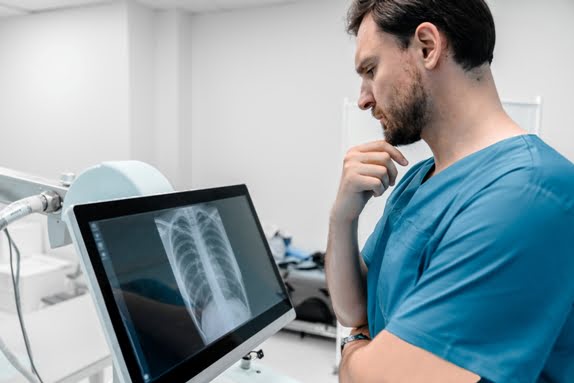Purpose and Indications
The Both Knee AP Standing Lateral Merchant’s View is specifically designed to capture detailed images of both knees in a standing position, which is crucial for evaluating the biomechanics and overall function of the knee joint under weight-bearing conditions. This view is often used to assess conditions like:
1] Patellar dislocation or subluxation: The Merchant's view allows for the identification of any abnormal positioning or tracking of the patella, which may contribute to pain, instability, or dysfunction in the knee joint.
2] Patellofemoral osteoarthritis: It helps evaluate the cartilage and bone surfaces of the patellofemoral joint, identifying degenerative changes, joint space narrowing, or bone spurs.
3] Chondromalacia patellae: This condition, characterized by the softening or damage to the cartilage beneath the patella, can be detected using this imaging view.
4] Joint malalignment: The Merchant’s view can assess the alignment of the patella within the femoral groove, which is important in diagnosing misalignments that can lead to further joint problems.
5] Fractures and trauma: In cases of traumatic injury to the knee, this view can help in evaluating the integrity of the joint surfaces and surrounding bones.
Looking for Both Knee AP Standing LAT Merchant's View X-ray in Pune? Diagnopein is the best digital X-ray test near me, offering high-quality imaging services. This specialized X-ray provides a comprehensive view of the knee joints, evaluating alignment, cartilage health, and structural integrity. Essential for diagnosing conditions like arthritis, ligament injuries, and joint abnormalities, it ensures accurate results using advanced digital technology with minimal radiation exposure. Whether you're managing chronic knee pain or recovering from an injury, our expert team provides precise diagnostics in a patient-friendly environment. Choose Diagnopein for reliable and convenient X-ray services in Pune.
Technique
The Both Knee AP Standing Lateral Merchant’s View is a variation of the classic Merchant’s view. The patient is positioned upright, standing with both knees flexed at approximately 30 degrees. This stance is essential for simulating the functional position of the knee during regular activities such as walking or squatting. The imaging setup involves a special radiographic technique where X-rays are directed at an angle, capturing both knees simultaneously, providing a bilateral comparison of the knee joints.
Here are the key steps in obtaining a successful Both Knee AP Standing Lateral Merchant’s View:
1] Patient Positioning: The patient is asked to stand in a relaxed position with both knees bent at about 30 degrees. The feet should be shoulder-width apart, ensuring that the weight is distributed evenly between both legs.
2] X-ray Beam Positioning: The X-ray tube is angled at approximately 30-45 degrees from the horizontal, directed at the patella of interest, while the X-ray receptor is positioned at the level of the knee joint.
3] Imaging: The radiographer ensures that both knees are captured in the same view, focusing on the patellofemoral joint for optimal visualization. A bilateral image is produced, allowing for comparison between the knees, which is important for detecting asymmetries or pathologies present in one knee but not the other.
4] Collimation: The radiographer ensures that the area of interest is well-collimated, typically limiting exposure to the knee joint area to minimize radiation to surrounding tissues.
The imaging technique requires careful positioning and attention to detail to obtain high-quality diagnostic images.
Advantages and Limitations
1] Simultaneous bilateral comparison: The primary benefit of the Both Knee AP Standing Lateral Merchant’s View is its ability to compare both knees side by side, allowing for a direct comparison of joint alignment, patellar position, and cartilage wear, which is invaluable in diagnosing conditions like patellar maltracking or arthritis.
2] Weight-bearing evaluation: Unlike many knee imaging techniques that are performed with the patient lying down, this view captures the knee joint in a weight-bearing position, providing a more accurate representation of how the joint behaves during normal function.
3] Detailed visualization: The Merchant’s view provides detailed imaging of the patellofemoral joint, which is crucial for diagnosing a range of knee pathologies that affect this area.









